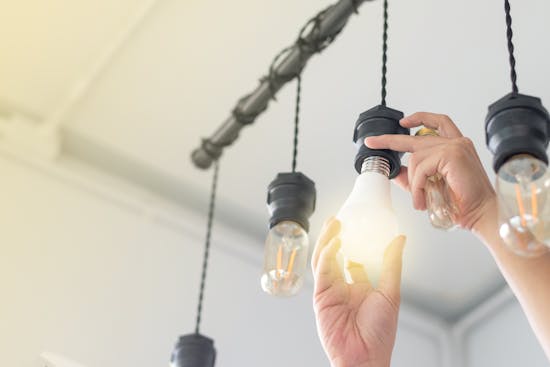If you’re buying an investment property, we know that you want to avoid a dud property investment on your first shot. With hundreds and thousands of dollars on the line, it’s only normal to feel anxious about making a misstep.
And even though it gets easier with a few years of experience, the fear that there’s something you’ve missed doesn’t quite go away.
We've broken down what you need to check, decide and be aware of so you can pick a good investment property with confidence.
1. How will you finance your property?
As much as we wish it wasn’t the case, you can’t have all the pros in property finance.
Depending on your financial strength and the amount of risk you’re willing to weather, you’ll need to make a choice between negatively gearing your property or positively gearing your property.
Negative gearing
If you negatively gear your property it means that you’re incurring more losses from the holding costs of your property than it generates in income (mostly rent).
You can then use your negative cash flow property to reduce your taxable income. All of this is done with the expectation that when you sell the property, the capital growth will make up for the loss over time with a nice profit on top.
It’s very viable, but a risky strategy since you need a solid financial grounding to begin with so you can cope with the regular losses the property will endure.
Negative gearing is a great option for making the most of your property investment if you can weather out the month-by-month losses for tax benefits on a yearly basis.
About 60% of property investors in Australia are negatively geared, making it the most popular option for property finance. But, the latest real estate news is saying that negative gearing is on a downward trend in popularity, and that positive gearing is making a comeback for 2021.
Read our in-depth article about negative gearing to understand if it's the right option for you.
Positive gearing
Just like the name suggests, positively gearing your property works in the opposite way to negative gearing. Instead of the property enduring regular losses, it makes a regular profit because it is generating more rent than what it takes to run it.
It’s a less risky strategy for sure. One that has a lot of appeal to first time buyers. But it’s not always the easiest strategy to initiate – you could be looking at properties in regional areas if you want to make it work.
Positive gearing is a great option for first-time buyers who want to secure an additional source of income.
The passive income can be pretty slim as well, and the capital growth may be considerably less than that of the negatively geared variety.
Make sure you read up on positive gearing to get its pros and cons and when to choose it before making your decision.
P&I or IO?
IO and P&I are short for Interest-Only and Principal and Interest. Both have their merits and drawbacks.
Interest-only loans mean that for a set initial period you only pay back the cost of interest on your loan (usually 1-10 years). After that period, you begin paying both interest and repaying the amount you borrowed.
There's no silver bullet to property finance, and both P&I and IO are valid, depending on your individual situation.
Principal and interest loans however, have you repay your loan as well as interest from the get-go. That way, you pay more in the start, but the total sum of your interest is lower, which means that you’re saving money in the long-term.
We’ve made an in-depth article about the best loan structure for investment property and when to pick P&I or IO, which we recommend reading before making your decision.
2. Where are you looking to buy?
The ‘where’ is just as important as the ‘what’. You need to have made up some thoughts about the location of your property, and how that affects your returns.
"Sell the location, not just the property."
Where do tenants want to live?
Different tenants want different things, but the following features and amenities are usually appreciated:
- Lots of restaurants in close proximity
- Public transport and train station in walking distance
- Being close to university (if you’re renting to students)
- School districts
- Short distance to a supermarket
- A nearby park
Having these features will let you charge a higher rent and fill vacancies faster when you’re leasing your property.
Read our article on how to research what tenants want to get a complete checklist.
Regional or urban?
Like most things in property, choosing between regional and urban areas is a tradeoff.
While urban areas have lower vacancy rates and good capital growth, they have a steep upfront cost and can be unobtainable for many investors.
Investing in regional areas has a lower barrier of entry, but is also associated with much higher vacancy rates and slower capital growth.
But, don’t write off regional areas too fast! Recent data shows that the regional property market is experiencing a boom in 2021 due to the COVID-19 pandemic triggering the work from home trend.
Investing in property overseas
Buying property overseas is one of the great low-cost ways to buy property.
While owning a romantic seaside house in the French Riviera is bragging rights in itself, this investment strategy has real benefits. To name a few, you get access to low-capital requirement properties, you avoid putting all your eggs in one basket (or one property market), and you can use it as your personal vacation home.
You can read our article on how to invest in property with little money for a full breakdown of the pros and cons of investing overseas.
3. What type of property are you looking to buy?
Depending on what investing journey you've imagined, different types of investments might appeal to you.
House, unit, or land?
While a plot of vacant land might have the appeal of being a blank canvas for your big development project, it’s not a popular option because of the amount of time and effort you need to spend to turn a profit.. Skill and in-depth knowledge of the area are vital if you want a chance at success. And since you won’t be earning any rent, staying on top of mortgage repayments can be very tricky.
Units, as well, aren’t all that forgiving for first time investors. Unlike houses, these properties come with strata fees and body corporate fees that can really cut into your cash flow.
Houses continue to be the most popular type of investment property, despite the higher price tag, with about 37.5% of new purchases being houses and 33.7% being units according to MCG Quantity Surveyors.
In the end, choosing the right investment property will come down to what you can afford and the level of risk you’re willing to take.
New or old?
Aside from the lack of property maintenance issues, what’s good about purchasing a new property is that you can claim far more in depreciation than you can with an old property on your property taxes. A great way to offset potential losses from those holding costs!
Just be wary if you’re buying brand new from a property marketing company since they have a tendency to add commissions atop the price.
Older properties, even though they can run the risk of hitting you with more maintenance costs, are a great opportunity to add value by renovating your property.
But, you’ll want to make sure you’re not buying something that will cost you more in repair than what it will make you in return. That’s why it’s a good idea, if you’re not familiar with how to do a property inspection, to enlist a professional building inspector before you make the purchase.
Residential vs commercial
The main benefit of choosing a commercial property over residential is that you’re likely looking at a higher rate of return - around 5% to 12%. This is because commercial tenants are responsible for paying the outgoings on the property, meaning that you’ll probably enjoy a positive cash flow.
Lease terms can also be much longer than your standard residential property which means you don’t have to worry about your property being vacant too regularly. At the same time, when commercial properties do go vacant, it can make much longer to fill the vacancy.
It’s also much easier to finance residential property. The usual borrowing amount is 80% for residential property while it’s only around 60% for commercial properties.
A great deal of knowledge is required before delving into the deep end of commercial property investment. You need to be in tune with the movements of the broader economy especially because demand (or lack thereof) for particular businesses will spell either success or disaster for your commercial property.
We recommend starting with a humble residential property, and you can start looking at commercial property once you’ve got some experience under your belt.
4. What to look for in an investment property
Doing your property inspection is not an area for slacking. Different physical attributes can have a huge impact on your rental yield.
Here’s what you need to look for when you’re inspecting a property you’re considering buying:
Features that determine the value of the rental
- Number of bedrooms in the house
- If there is a separate dining room
- Size of the rooms and wardrobes
- The number of bathrooms in the house
- The size and state of the kitchen
- How much storage there is in the house
- If it has a garage
- If the place is secure (i.e. no windows that are easy to break into). This will impact how much you pay in insurance.
- If the property has easy parking
- If the property will need a lot of maintenance
General state of the house
- Check for cracks and holes in the walls
- Check for mould and water stains
- Make sure the air in cabinets is not damp or mouldy
- Check if anything needs to be repaired
- Check for any sagging parts of the ceiling. You can do this by shining a flashlight and looking for any pockets that look like a parachute.
- No rust in the gutters
- Make sure all the roof tiles are straight and in good shape
After buying, make sure that you're conducting routine inspections to keep the property in tip-top shape! After all, interested buyers will look at the same things you once did when it's time to sell.
5. Can you cover all the costs involved in buying an investment property?
If you thought that the price of the house was all you had to pay, then we’ve got some bad news for you!
To get the true cost of investing in property, you also need to consider:
- Valuation fee (approx. $300 for a property worth up to $1m)
- Stamp Duty (approx. $9000 to $42,000 for properties between $310k and $1m)
- Legal fees (approx. $100)
- Lenders Mortgage Insurance (approx. $20,000 for $1m property with a 10% deposit)
- Loan fee (approx. $150-$700)
Not to mention the ongoing holding costs – utilities, insurance, repayments, council rates and all. Here’s a handy calculator that can help give an estimate of some of these purchasing costs.
6. How much can you borrow?
When it comes to taking out a mortgage, you can expect to put down a 20% deposit. That’s the standard.
It is possible to borrow up to 85%, 90%, and even 95%, but the eligibility criteria for these become more and more strict, as you’d expect.
But the main things to keep in mind when approaching lenders is that they will be looking closely at your:
- Genuine savings (money you have accumulated in your bank account that will go towards your deposit)
- Employment status
- Income
- Credit history
Getting pre-approved for a loan before you go property-shopping is good practice.
If you can show that you’re adequately satisfying all these requirements, you should have a good shot at securing a loan.
It’s also a really good idea to get pre-approval from your bank first. Otherwise, you could end up being declined for a mortgage right after you’ve put down the holding deposit.
7. Should you get a property manager?
Did you know that 80% of property investors in Australia use a property manager?
Owners have all types of reasons for bringing a professional on board to manage their properties, but it boils down to these main reasons:
- Time savings. It’s worth it to pay a few hundred bucks for a property manager so that you can keep your full-time job, instead of quitting to become a full-time self-managed owner.
- Getting an expert to manage your properties. Property managers have local knowledge and can come up with great ideas to increase your rental yield and capital growth.
- Finding tenants. Property manager leasing services is a great way to find good tenants and get rid of a vacancy.
- They handle property maintenance for you, which is known to be a source of headache.
- They collect your rent, and keep things running smoothly so you don’t have to spend your mental bandwidth on your investment property.
"I usually recommend to my clients that they manage their first investment property themselves. There's a good reason for this: It gives them a good insight into how much work property managers actually do to earn the relatively small fee they receive each week."
8. Are you prepared for the unexpected?
It’s an inconvenient truth, but at the end of the day you can’t escape the fact that buying your first investment property in Australia is a risky business.
Many things can rear their ugly head and bring with them some hefty, unexpected costs.
Vacancies, bad tenants, property damage, and decreased property value from market downturns are just some of the unfortunate events that can hit your wallet hard.
Because of this, having a financial buffer is essential. Between two to four months of your rental income should be a safe amount.
9. Do you know your legal obligations?
If you want to avoid any potential legal mishaps, it’s a good idea to familiarise yourself with the landlord-tenant laws.
As an owner, you have many responsibilities to your tenant that range from the matter of preparing the tenancy agreement and supplying an entry report, to maintenance and eviction. So, staying on top of these things is a necessity!
Want more insights into the world of property management and real estate?
Subscribe to our FREE quarterly newsletter for the best property content on the internet!
Disclaimer: The information provided on this blog is for general informational purposes only. All information is provided in good faith; however, we do not account for specific situations, facts or circumstances. As such, we make no representation or warranty of any kind whatsoever, express or implied, regarding the accuracy, adequacy, validity, reliability, availability or completeness of any information presented.
This blog may also contain links to other sites or content belonging to or originating from third parties. We do not investigate or monitor such external links for accuracy, adequacy, validity, reliability, availability or completeness, and therefore, we shall not be liable and/or held responsible for any information contained therein.




.png?ixlib=gatsbyFP&auto=compress%2Cformat&fit=max&rect=0%2C0%2C4000%2C1400&w=700&h=245)

